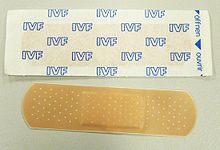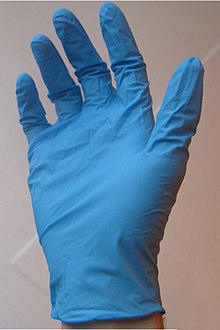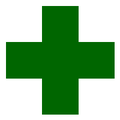First aid kit

A first aid kit is a collection of supplies and equipment for use in giving first aid.[1] First aid kits may be made up of different contents dependant on who has assembled the kit and for what purpose. It may also vary by region due to varying advice or legislation between governments or organisations.
Common contents include items to help control bleeding, such as bandages, breathing barriers for performing CPR (cardiopulmonary resuscitation), and may contain some medicines.
Format
First aid kits can be assembled in almost any type of container, and this will depend on whether they are commercially produced or assembled by an individual. Standard kits often come in durable plastic boxes, fabric pouches or in wall mounted cabinets. The type of container will vary depending on purpose, and they range in size from wallet sized through to large rucksacks.
It is recommended that all kits are in a clean, waterproof container to keep the contents safe and aseptic.[2] Kits should also be checked regularly and restocked if any items are damaged or out of date.
Appearance
The International Organization for Standardization (ISO) sets a standard for first aid kits of being green, with a white cross, in order to make them easily recognisable to anyone requiring first aid.
-
ISO First Aid Symbol
-
Alternate version of the first aid symbol
-
Symbol of the Red Cross
-
Star of life
Whilst the ISO recommend the use of the green background and white cross, some individuals or organisations use a red cross on white background, but use of this symbol by anyone but the International Committee of the Red Cross (ICRC) or associated agency may be illegal under the terms of the Geneva convention, which designates the red cross as a protected symbol in all countries signatory to it. One of the few exceptions is in North America, where Johnson & Johnson has permission to use the red cross as a trademark on its products and registered the symbol for use in 1887.
Some first aid kits may also feature the star of life, normally associated with emergency medical services, but which are also used to indicate that the service using it can offer an appropriate point of care.
Contents



Commercially available first aid kits available via normal retail routes have traditionally been intended for treatment of minor injuries only. Typical contents include adhesive bandages, regular strength pain medication, gauze and low grade disinfectant.
Specialized first aid kits are available for various regions, vehicles or activities, which may focus on specific risks or concerns related to the activity. For example, first aid kits sold through marine supply stores for use in watercraft may contain seasickness remedies.
Airway, Breathing and Circulation
First aid treats the ABCs as the foundation of good treatment. For this reason, most modern commercial first aid kits (although not necessarily those assembled at home) will contain a suitable infection barrier for performing artificial respiration as part of cardiopulmonary resuscitation, examples include:
Advanced first aid kits may also contain items such as:
Trauma injuries
Trauma injuries, such as bleeding, bone fractures or burns, are usually the main focus of most first aid kits, with items such as bandages and dressings being found in the vast majority of all kits.
- Adhesive bandages (band-aids, sticking plasters) - can include ones shaped for particula body parts, such as knuckles
- Moleskin— for blister treatment and prevention
- Dressings (sterile, applied directly to wound)
- Sterile eye pads
- Sterile gauze pads
- Sterile non-adherent pads, containing a non-stick teflon layer
- Petrolatum guaze pads, used a an occlusive(air-tight) dressing for sucking chest wounds, as well as a non-stick dressing
- Bandages (for securing dressings, not necessarily sterile)
- Gauze roller bandages - absorbent, breathable, and often elastic
- Elastic bandages - used for sprains, and pressure bandages
- Adhesive, elastic roller bandages(commonly called 'Vet wrap') - very effective pressure bandages or durable, waterproof bandaging
- Triangular bandages - used as slings, tourniquets, to tie splints, and many other uses
- Butterfly closure strips - used like stitches to close wounds, usually only included for higher level response as can seal in infection in uncleaned wounds.
- Saline for cleaning wounds or washing out foreign bodies from eyes
- soap - used with water to clean superficial wounds once bleeding is stopped
- Antiseptic wipes or sprays for reducing the risk of infection in abrasions or around wounds. Dirty wounds must still be cleaned for antiseptics to be effective.
- Burn dressing, which is usually a sterile pad soaked in a cooling gel
- Adhesive tape, hypoallergenic
- Hemostatic agents may be included in first aid kits, especially military or tactical kits, to promote clotting for severe bleeding.
Personal protective equipment
The use of personal protective equipment or PPE will vary by kit, depending on its use and anticipated risk of infection. The adjuncts to artificial respiration are covered above, but other common infection control PPE includes:
- Gloves which are single use and disposable to prevent cross infection
- Goggles or other eye protection
- Surgical mask or N95 mask to reduce possibility of airborne infection transmission (sometimes placed on patient instead of caregivers. For this purpose the mask should not have an exhale valve)
- Apron
Instruments and equipment
- Trauma shears, for cutting clothing and general use
- Scissors are less useful but often included instead
- Tweezers
- Lighter, for sterilizing tweezers or pliers etc
- alcohol pads for sterilizing equipment, or unbroken skin. This is sometimes used to debride wounds, however some training authorities advise against this as it may kill cells which bacteria can then feed on
- Irrigation syringe - with catheter tip for cleaning wounds with sterile water, saline solution, or a weak iodine solution. The stream of liquid flushes out particles of dirt and debris.
- Torch (also known as a flashlight)
- Instant-acting chemical cold packs
- Alcohol rub (hand sanitizer) or antiseptic hand wipes
- Thermometer
- Space blanket (lightweight plastic foil blanket, also known as "emergency blanket")
- Penlight
Medication
Medication can be a controversial addition to a first aid kit, especially if it is for use on members of the public. It is, however, common for personal or family first aid kits to contain certain medications. Dependant on scope of practice, the main types of medicine are life saving medications, which may be commonly found in first aid kits used by paid or assigned first aiders for members of the public or employees, painkillers, which are often found in personal kits, but may also be found in public provision and lastly symptomatic relief medicines, which are generally only found in personal kits.
Life saving
- Aspirin[2] primarily used for central medical chest pain as an anti-coagulant
- Epinephrine auto-injector (brand name Epipen) - often included in kits for wilderness use and in places such as summer camps, to treat anaphylactic shock.
Pain killers
- Paracetamol (also known as Acetaminophen) is one of the most common pain killing medication, as either tablet or syrup
- Anti-inflammatory painkillers such as Ibuprofen, Naproxen or other NSAIDs can be used as part of treating sprains and strains
- Codeine which is both a painkiller and anti-diarrhoeal
Symptomatic relief
- Anti diarrhea medication such as Loperamide - especially important in remote or third world locations where dehydration caused by diarrhea as a leading killer of children
- Oral rehydration salts
- Antihistamine, such as diphenhydramine
- Poison treatments
- Absorption, such as activated charcoal
- Emetics to induce vomiting, such as syrup of ipecac although first aid manuals now advise against inducing vomiting.
- Smelling Salts (ammonium carbonate)
Topical Medications
- Antiseptic ointment, fluid, moist wipe or spray, including benzalkonium chloride, Neomycin, Polymyxin B Sulfate or Bacitracin Zinc.
- povidone iodine is an antiseptic in the from of liquid, swabstick, or towlette
- Aloe vera gel - used for a wide variety of skin problems, including burns, sunburns, itching, and dry skin; used as a substitute for triple-antibiotic gel to keep a wound moist and prevent bandages from sticking
- Burn gel - a water-based gel that acts as a cooling agent and often includes a mild anesthetic such as lidocaine and, sometimes, an antiseptic such as tea tree oil
- Anti-itch ointment
- Hydrocortisone cream
- antihistamine cream containing diphenhydramine
- Calamine lotion
- Anti-fungal cream
- Tincture of benzoin - often in the form of an individually sealed swabstick, protects the the skin and aids the adhesion of butterfly strips or adhesive bandages.
Improvised uses
Besides its regular use in first aid, many first-aid items can also have improvised uses in a survival situation. For example, alcohol pads and petroleum jelly-based ointments can be used as a fire-starting aid in an emergency, and the latter can even be used as an improvised lubricant for certain mechanical devices, and adhesive tapes and bandages can be used for repairs. These alternate uses can be an important consideration when picking items for a kit that may be used in wilderness or survival situations. An alternative could however also be the use of additional kits with tools such as Survival kits and Mini survival kits.
Trauma Bag/First Responder Bag
Emergency responders use a more advanced medical kit called a trauma bag or a first responder bag containing greater quantities of material, of higher quality, than commercially available first aid kits.
See also
References
- ^ Windale, Rose. "Saving lives with Emergency Medicine". healthzine.org. Retrieved 2008-12-19.
- ^ a b First Aid Manual 8th Edition. St John Ambulance, St Andrews First Aid, British Red Cross. 2002. ISBN 0-7513-3704-8.




